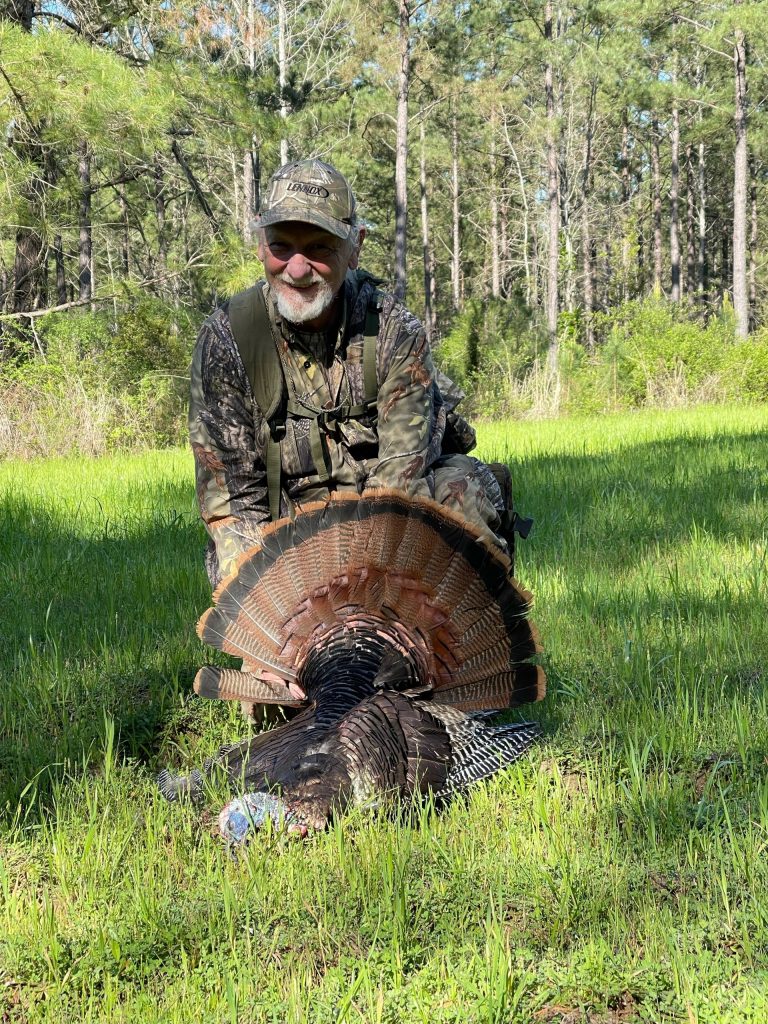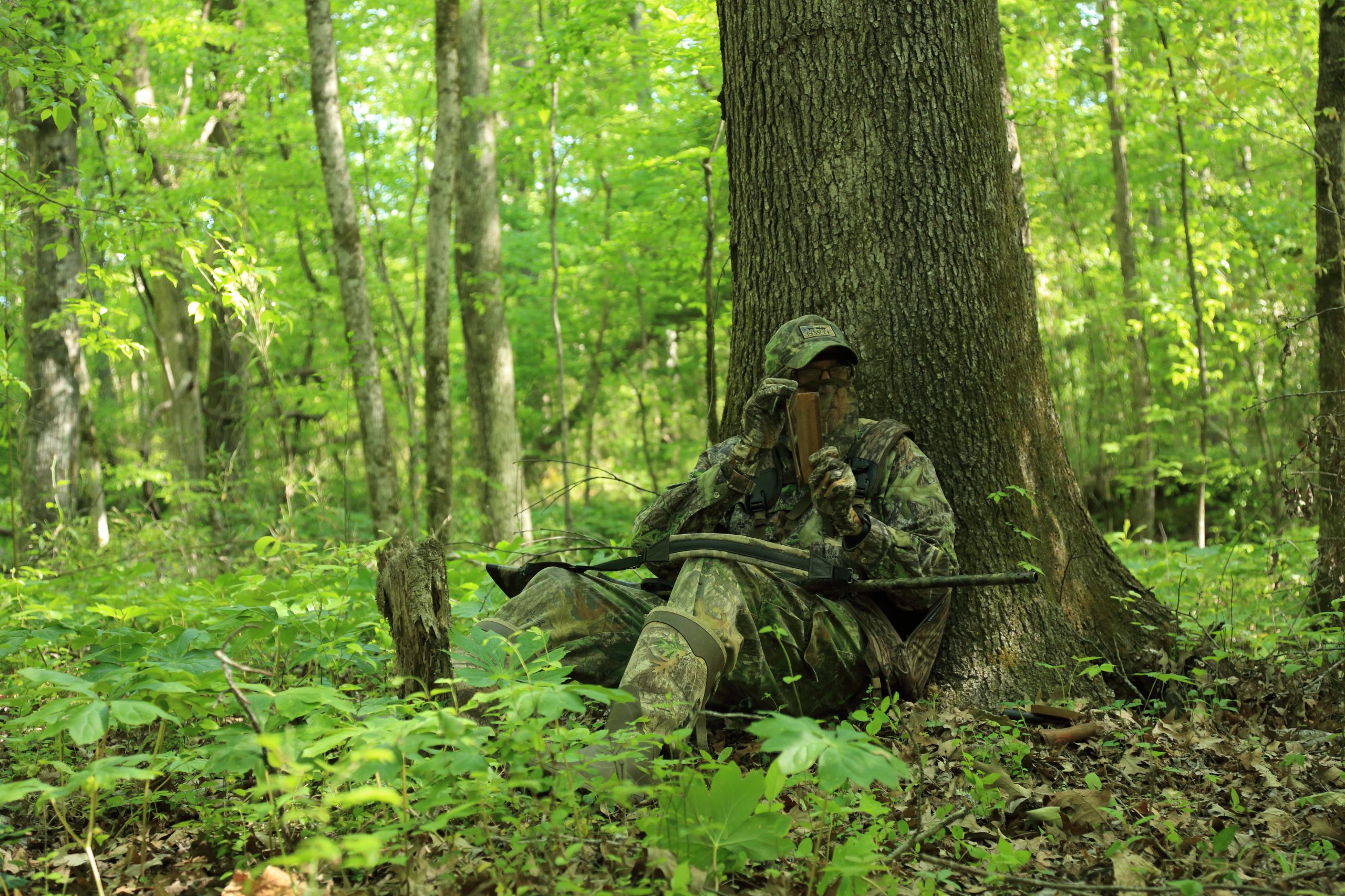Tom Fool-ery!
Novices can use these tips to bag more gobblers
Many sportsmen who hunted other game or those just starting their hunting careers might want to try turkey hunting, but don’t know how to do it.
For those who prefer to go it alone, this expert advice from two skilled turkey hunters in Mobile, Ala. might help. Kenny Weiss, a lifelong turkey hunter, conducts the annual National Wild Turkey Federation-sanctioned World Turkey Calling Championship in Mobile. His son, Kenny “K.J.” Weiss, Jr., already won two turkey calling world championships and four national championships plus many other honors.
“A beginner needs to learn how to make a basic yelp call,” K.J. advised. “All turkeys make that call. Different versions of a yelp can mean different things to a turkey. If someone calls really aggressively, like yelping hard, loud and fast, that’s exciting to turkey. A long drawn-out yelp is more like an assembly call telling the flock to come back together.”
Of course, to bag a turkey, sportsmen must first find birds. This requires scouting. Find where birds already want to go and beat them to it. To find the best spot, look for sign.

“In an area known to hold turkeys, look for tracks,” Kenny explained. “Generally, a gobbler track is a little bigger than a hen track. A gobbler has about a 30-inch stride. A hen has about a 12-inch stride. Put the heel of a foot on one track. If the toes touch another track, that’s usually a hen.”
Also look for scratch marks on the ground. Gobblers like to strut in open areas such as fields and clearings where hens can see and admire them. While strutting, they dragged their wings across the ground. Strut marks prove that a gobbler lives in that area.
Turkeys like deer food plots, freshly burned areas and clear-cuts. Fire eliminates thick underbrush and ground debris. As more sunlight reaches the soil, new shoots spring up. Turkeys regularly roost near water. A small creek running through a freshly burned area makes a great place to find turkeys.

When scouting, listen for gobbling or other calls. Turkeys roost in trees to escape from bobcats, coyotes and other predators. The dominant gobbler in an area keeps a harem of hens around him and fights other gobblers to maintain his top position. Gobblers call to their hens at first light. When scouting, don’t use a turkey call. In the darkness or at first light, hoot like an owl. During daylight, do a crow call. Turkeys sometimes respond to such calling by gobbling and giving away their positions.
“The biggest mistakes beginner turkey hunters make is trying to get too close to the bird and overcalling,” Kenny opined. “A person should set up about 150 to 200 yards away from a gobbler. If a person crowds a gobbler too much and the hens don’t come in like they should, he knows something is wrong.”
In heavily hunted public properties, find several places to hunt. Another hunter might get to the prime location first. As the season progresses, that gobbler located last week could be in freezer now. Since many public land hunters go to the easiest places to reach, seek less accessible spots to hunt.
Get to a good spot early, long before first light. Hide and stay still. Turkeys can’t smell, but they have great vision and can easily catch movement. As the forest slowly begins to brighten, fortunate hunters hear gobbling several hundred yards away.
“Turkey hunters must be really well camouflaged,” Kenny emphasized. “We’re hunting in their living rooms so a person must look like their surroundings. Turkeys survive by their eyesight and hearing. Hunters must stay quiet, still and completely covered. Cover up everything a turkey can see that looks like a human. Wear a face mask and gloves to blend in with the surroundings.”
Sportsmen can use several different call types. One of the easiest calls to use, a box call looks like a small box. Slightly wider and longer than the box, the “paddle” or “lid” sits at the top of the box. Loosely attached, it moves back and forth. Hunters make different sounds by rubbing the paddle over the box. Other calls include “friction” types where someone rubs two objects together. Many experienced callers prefer mouth calls. With a call inside a hunter’s mouth, that person doesn’t need to make unnecessary movements as the bird approaches.
“For a novice getting into turkey hunting, I recommend they learn how to use a box or a pot call,” Kenny suggested. “Pot calls could be slate or glass, but I recommend a slate call. It’s a lot more forgiving than some other calls made with different materials. People can use a box call and a slate in conjunction with each other. With a box call, turn the open end facing toward the bird if it’s a long way away so the sound carries farther. When it gets closer, turn the open side of the box away from the bird so it’s not as loud. That way, the gobbler thinks the hen is leaving him.”
Frequently, a gobbler hears a human calling and stealthily moves closer to investigate. It might “hang up” out of sight and out of range. Novice callers might think if they call more frequently and louder, that bird will come in running. Usually, the opposite happens. Too much calling could alert the cagy critter.
“If the bird answers the calling, don’t completely stop calling,” Kenny remarked. “Call and listen. If the bird doesn’t gobble for eight to 10 minutes, call again. Try to figure out if he’s coming closer or getting farther away.”
Hunters in full camo sounding like turkeys could call in more than birds. A bobcat might hear that call and think it’s stalking breakfast. Worse, especially on heavily hunted public properties, another hunter hears the call and shoots at the slightest movement. NEVER PULL THE TRIGGER WITHOUT POSITIVELY IDENTIFYING THE TARGET AND WHAT’S BEHIND IT. If someone does approach within range, let that person know where you are, if it means missing a turkey.
“When hunting public land, I always caution people not to gobble,” K.J. warned. “I know people who have been shot more than once while hunting public land because someone hears a gobble and shoots into the blind or at anything that moves. Even on private land, watch out for other people.”
To learn how to call and other strategies for turkey hunting, sportsmen can find a wealth of instructional videos by noted expert callers on the internet to get people started on their turkey hunting careers.
To get more personal instruction on calling, come to the next NWTF-sanctioned World Turkey Calling Championship, slated for June 7-8, 2024, at the Arthur R. Outlaw Mobile Convention Center, located at One South Water Street in Mobile, Ala.
Each year, some of the most renowned callers, including several world or national champions, attend the World Turkey Calling Championship to compete, judge or just watch. Between judged events, spectators can mingle with several outstanding turkey callers, including many champions, ask them questions, see their calls and learn how to become better turkey hunters.
